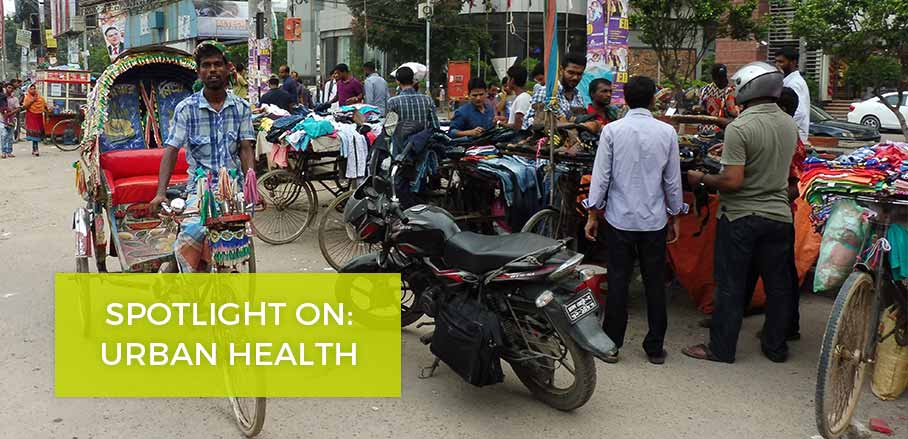Cities are Engines of Transformation – and Urban Health is the Fuel
By Maria Jose Amilibia
The benefits of cities are rarely distributed equitably. Particularly for the poor and disadvantaged, cities have a high rate of health hazards and risks. To address these dangers, city leaders need to take a multidisciplinary, rights-based approach. Maria Jose Amilibia argues that by leveraging cities’ unique opportunity to scale up essential services, we can truly transform the urban health landscape.
Cities offer many benefits, but these benefits are rarely distributed equitably. [inlinetweet prefix=”” tweeter=”urbanet_info” suffix=””]For many urban residents—particularly the poor and disadvantaged—cities have a high rate of health hazards and risks[/inlinetweet]. To prevent and control these health challenges, city leaders need to take a multidisciplinary approach, linking to actions in other development sectors. They should prioritise human rights and use innovative strategies to harness community participation. [inlinetweet prefix=”” tweeter=”urbanet_info” suffix=””]If city leaders take bold steps, they can leverage cities’ unique opportunity to scale up essential services like universal health coverage, and truly transform the urban health landscape[/inlinetweet].
The future of human health
The future of human health and development will be shaped by cities and other urban areas. By 2050, more than two-thirds of the world’s population are expected to live in urban centres. The actions of city leaders will therefore have a profound impact on public health, especially in low- and middle-income countries, where more than 95 percent of projected urban growth will occur.
Cities are engines of transformation: they are home to the largest and most dynamic economies, energised by young, mobile, and diverse populations with talent and innovation. Cities are vibrant hubs of learning and creativity, which make them ideal laboratories for developing better (and potentially more equitable) societies. But the pervasive inequality in cities—which is more obvious than in rural areas—can stand in the way of development.
[inlinetweet prefix=”” tweeter=”urbanet_info” suffix=””]The health disparities linked to inequality are especially visible in urban slums and informal settlements[/inlinetweet]. An estimated one billion people live in overcrowded and poorly serviced slums, the vast majority of them in developing countries. More than 30 percent of city residents in less developed countries live in slum areas; in sub-Saharan Africa, this proportion exceeds 60 percent.
These disadvantaged communities usually struggle to compete for essential services. Lack of shelter, safe water, acceptable sanitation, healthy food, basic education, and health care are endemic problems, along with high unemployment, physical insecurity, and environmental hazards. These conditions leave people vulnerable to poor health, and can block their access to treatment and care, leading to multiple health risks.
Addressing unique urban health needs
The [inlinetweet prefix=”” tweeter=”urbanet_info” suffix=””] public health professionals of tomorrow must understand the unique issues facing cities and be prepared to address them[/inlinetweet]. They will need to take a multi-disciplinary, rights-based approach that tackles the underlying social inequalities. To have the greatest impact, urban health efforts should link with actions in other development sectors and involve the active participation of affected communities.
Cities have to find the courage to change regulations or enact by laws that facilitate evidence-based public health programmes. Urban health leaders need to realise that the most effective actions prioritise the rights and needs of residents, irrespective of their legal status or entitlements. These efforts must align with the realities of people’s lives, using innovative ways to support and harness community participation. Through creative methods, cities can provide challenging but vital services on a massive scale in all kinds of settings.
Inclusion is the first step in this transformation process, and universal health coverage is a key strategy. The right to health means access to universal health care: good quality, timely, acceptable, affordable, and appropriate care. All over the world, countries are investing in universal health coverage by enabling people to make better decisions about their own health; by building networks of primary care clinics to provide treatment for everyday health needs; and by providing sophisticated services at hospitals.
The cornerstone of sustainability
Global sustainability will only be achieved via urban sustainability. None of the Sustainable Development Goals can be achieved without considering the urban dimension. Productive cities lay the foundation for economic development, so cities are critical agents of international development. More technical expertise and capacity development should be focused on achieving Sustainable Development Goal 11: to make cities inclusive, safe, resilient, and sustainable.
Cities have a unique opportunity to scale up the most effective programmes and reach large numbers of people living in relatively compact areas. Today’s cities are taking action, but they can go farther. We need to see more constructive actions, especially in low- and middle-income countries over the next 10-20 years. If “the fate of the world will be decided in cities,” as Fernand Braudel wrote, then urban health care will be the cornerstone.
